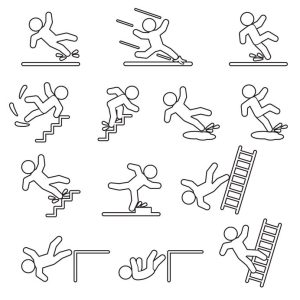
There are valuable tools a personal trainer can add to a client’s repertoire that will improve overall functionality and resiliency, among which falling safely is one of the most useful, especially for an aging population.
Serious falls begin so innocently: you take the family dog for a walk and trip on a fallen branch; you mistake black ice for a clear patch of sidewalk; a client stumbles over the corner of an exercise mat. Whatever the circumstances, such tumbles may result in serious head trauma, hip fractures, or injuries with long-lasting effects. We have the potential to lessen both the incidence as well as the severity of such occasional mishaps by learning How To Fall.

Sobering Statistics
A study presented in the Journal of Allied Health revealed that individuals in the age demographic of 50- to 60 years tend to suffer more falls than their elderly counterparts. A simple bone fracture or other fall-related injury can be serious in its own right; many experts consider a fall to signify the beginning of a dangerous downward spiral for the elderly, infirm and frail.
Centers for Disease Control and Prevention found that individuals are more inclined to suffer a traumatic brain injury from a serious tumble than from any other cause. In fact, the CDC also found that “approximately 20% of older adults hospitalized for a hip fracture die within a year and about 50% will suffer a major decline in independence.”
Begin with the End in Mind
While we cannot possibly predict or prevent every misstep or fall, we can learn how to improve footing and increase our odds of a safe landing on the ground. Taking the time to teach clients about the “science of falling” and how best to prepare themselves will benefit them throughout every stage of their lives.
The ability to be “mindful”– aware of one’s surroundings– encompasses a variety of thought patterns, not the least of which should include a potential escape route. In the case of falls, this means knowing the best way to embrace the fall as it is happening as well as the safest ways of landing to avoid serious injury. Training your clients to focus on the present activity, not the next exercise in their workout program, can help improve overall mindfulness.
It is not outside a personal trainer’s scope of practice to inquire if a client has observed any blind spots during activities of daily life (ADLs). If so, the remedy could be as simple as suggesting a tweak in prescription eyeglasses or contact lenses. Often clients will talk to us about a pet who is always underfoot, or occasionally slipping on his favorite Persian rug in the hallway. Gently remind him that if he cannot see the obstacle, he increases his chances of tripping on it.
The (Lifesaving) Balancing Act
By spending a few minutes on balance at the conclusion of each training session, we can help ease the trepidation many older individuals feel about their own stability. Ask the client to stand tall with his feet together. He can then proceed to raise one foot about an inch off the floor, and hold this position for 30 seconds. After 10 reps, repeat with his other foot. If at first the client hesitates, offer a stable structure onto which he can hold until he feels more comfortable with his abilities.
Risk Assessment
While training a client, pay close attention to any weakness and muscle imbalances. Once noted, there are many exercises that can be used to facilitate strength and agility that do not require equipment. Try side-to-side jumps or leaps, and going quickly up and down a low set of steps.
Tried and True Tips for Falling Safely
The time to learn how to safely absorb the impact of a fall is, of course, before it happens. According to professional stuntwoman Alexa Marcigliano, the best way to proceed is “be smooth, don’t panic, stay loose.” In doing so, by bending elbows and knees, one can prevent what the medical profession refers to as FOOSH, or “falling on an outstretched hand”. This is the type of impact that most often results in a broken elbow or wrist.
The key is to roll with the fall, much like paratroopers are taught to do. “The idea is to orient your body to the ground so when you hit, there’s a multistep process of hitting and shifting your body weight to break up that impact,” said Sgt. First Class Chuck Davidson, master trainer at the Army’s Advanced Airborne School at Ft. Bragg, NC. The most difficult aspect is fighting the human instinct to halt the body as quickly as possible. However, from a physics point of view, giving in to the fall is the safest route.
Always Maintain a “Heads-Up” Position
While hips and knees and other joints/bones can be repaired, head trauma takes injury to a much more deleterious level. If a client were to find himself falling forward, the best advice is to turn his face to the side to avoid a direct head collision with the ground. If leaning backward is a threat to stability, keeping the chin tucked toward the chest can minimize chances of the back of the head striking the ground. If possible, attempt to position the body so as to land on padded, fleshy tissue such as muscle, specifically on the quads or the glutes.
In the event of a side tumble, attempt to grab the hip with the opposite arm to avoid landing directly on the bone. Rolling toward one’s back once down likewise minimizes the impact.
None of us plans on falling, but life often throws obstacles in our paths. The best way to safeguard our health is to be prepared for such an emergency. Stay present, stay loose, stay mindful and aware!
Learn more in our Functional Training Specialist as a part of our Continuing Education Course Series.

References
www.smartcellsusa.com/senior-falls-how-to-fall-safely/
www.aarp.org/health/conditions-treatments/info-2017/how-to-fall-safely.html






